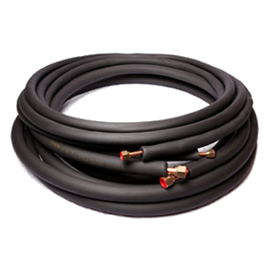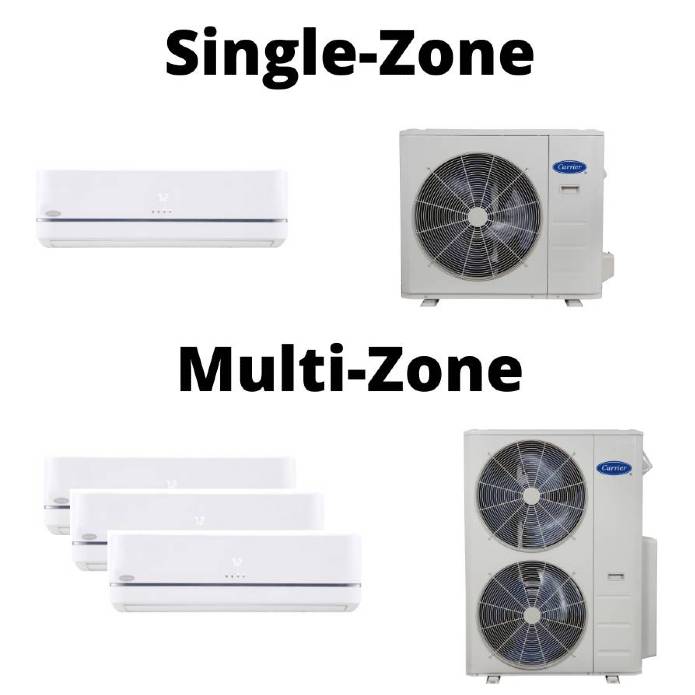What Is The Average Cost To Install A Carrier Mini Split In A Pennsylvania, New Jersey, or Delaware Home?
UPDATED: January 2024
Mini split installations cost around $6,500 for a single-zone system, air conditioning-only, and up to $45,000 or more for whole-home heat pump solutions that heat and cool your home here all year in Pennsylvania, New Jersey, and Delaware. The cost of a mini split increases based on a number of factors, such as the number of indoor spaces you need to condition and the distance between your outdoor unit and your indoor air handler.


You’ve got a lot of options to choose from when it comes to ductless heating and cooling. Do you need a single-zone system for a home office, garage workshop, or that one room that’s never warm or cool enough?
Or are you upgrading your comfort for your entire home? Or something in between?
You can do it all with a mini split. And, your home will be much more comfortable than ever before.
Plus, with the proper setup, you’ll save so much on your utility bills that you’ll eventually make back the money you spent to install it.
But going through all the options can be overwhelming. You may even be tempted to install the mini split yourself (which isn’t a good idea). That’s why we wrote this article. It covers:
- Mini Split Parts (And How They Work)
- Single Zone Vs. Multi-Zone Units
- Hyper Heat Vs. Regular Heat Pumps
- Saving Money With Ductless Heating And Cooling
- Mini Split Installation In Pennsylvania, New Jersey and Delaware
Once you’re done here, you’ll be ready to picture the perfect customized system for your home! And, we’ll be here to help make it a reality.
Click below to find the Carrier ductless specialist near you, or call us at 484-370-4440 to schedule your free consultation.
Mini Split Parts (And How They Work)
Let’s start with the basics: What parts make up a mini split, and how they work together to make your home so comfortable. If you already know the basics, skip ahead. If not, keep reading:
Air Handlers


The air handlers are the indoor units. They draw in the air from the room, heat or cool it, and then recirculate the air.
Today’s models do a fantastic job of maintaining a steady temperature no matter where you are in the room.
These units have up to 32 airflow patterns to handle any size or shape room. This comes in handy for everything from big rooms with high ceilings to dining room and kitchen areas with a doorway in between them.
The most popular air handler model is the high wall unit:
Then, there’s a low-wall unit:
And finally, a recessed cassette that mounts flush with the ceiling:
You can mix and match in different rooms based on each space’s needs.
Heat Pump
The outdoor unit, or heat pump, is responsible for sending heat into your home during the winter and removing it during the summer.
It uses a heat transfer process rather than burning fossil fuels to generate warmth (we’ll touch on that again later).


Your load requirements (how much power it needs for heating and cooling) determine what size model you need. That changes based on how many rooms you’re treating.
After that, you can choose one based on how much of the year you plan to use it. These systems come in ductless and ductless setups. The cost to install a heat pump relies in large part on what kind of system it uses.
Line Set
Ductless systems use a coolant liquid, or refrigerant, to transfer heat from the air handler to the heat pump and vice versa.
It travels in flexible tubing between the two units, and we can usually run it through the wall where you can’t see it.


Single Zone Vs. Multi-Zone Units
The biggest cost factor is whether you want a single zone or multi-zone mini split. A single zone has one heat pump and one air handler inside. It’s perfect for treating a single room or area of the house.


You can add up to eight air handlers on most heat pumps to treat more parts of the house. The cost can double with each additional indoor unit depending on the installation.
And, eventually, you’ll need a bigger heat pump to treat more space.
There’s the option to add more air handlers later, but tell your contractor that upfront. If they install a single-zone heat pump, you’ll need a new one later for the extra indoor units.
Saving Money With Ductless Heating And Cooling
For as large as the price tag can get, you’ll save more money with ductless heating and cooling over time than with any other HVAC system out there! In most cases, we see people get the full return on their investment in five years.
By then, the difference between what they used to pay on their utility bills versus what they paid after going ductless is enough to cover the cost of their mini split installation.
And, in most cases, the value of a home increases with a mini split installation.
But how?
First, there’s the fact that heat pumps don’t burn expensive natural resources to create heat.
Instead, they take what little warmth there is outside, even in the coldest weather, and amplify it so that it’s strong enough to heat your entire home.
All you pay for is the small amount of power it needs to run.
Next, today’s variable speed models don’t stop and start a few times every hour like conventional HVAC systems. Instead, they run in a low-speed, low-power mode nearly all the time.
It always keeps the temperature within a degree or two of your setting.
It’s like cruise control for your car: You use less gas on the open road than when you’re stopping and starting at stop signs and red lights. The same goes for your variable-speed mini-split.
That doesn’t just save you money. It also makes your home much more comfortable.
Mini Split Installation In The Mid Atlantic Region
The last big question we get is: Why are these prices so much higher than what we found online? And, the answer is simple: Those costs are just for the parts, not the installation.
And while it’s tempting to save money with the DIY route, you’ll end up paying way more in the long run.
To start, you need a professional load calculation to determine what size heat pump you’ll need. And which air handlers will perform best in your home’s unique layout.
Without that, you run the risk of having your system break down quickly because it never works the way it should. And, you’ll have hot and cold spots and uneven temperatures throughout your home.
There’s also the risk of damage and injury if an air handler falls off the wall. It’s more common than you may think. And, it’s very dangerous.
Then, there’s the warranty. Every manufacturer requires a certified, professional HVAC contractor to install the units. Otherwise, they won’t honor the warranty if something goes wrong.
Fortunately, you’re in the right place! We’ll match you with a contractor who specializes in ductless systems. They’ll help you create a customized solution for your home and your needs.
And, you’ll be confident that they’ll install it the right way the first time. Finally, your home will finally be as comfortable as you’ve always wanted it.
Click below or call us at 484-370-4440 to schedule your free consultation.